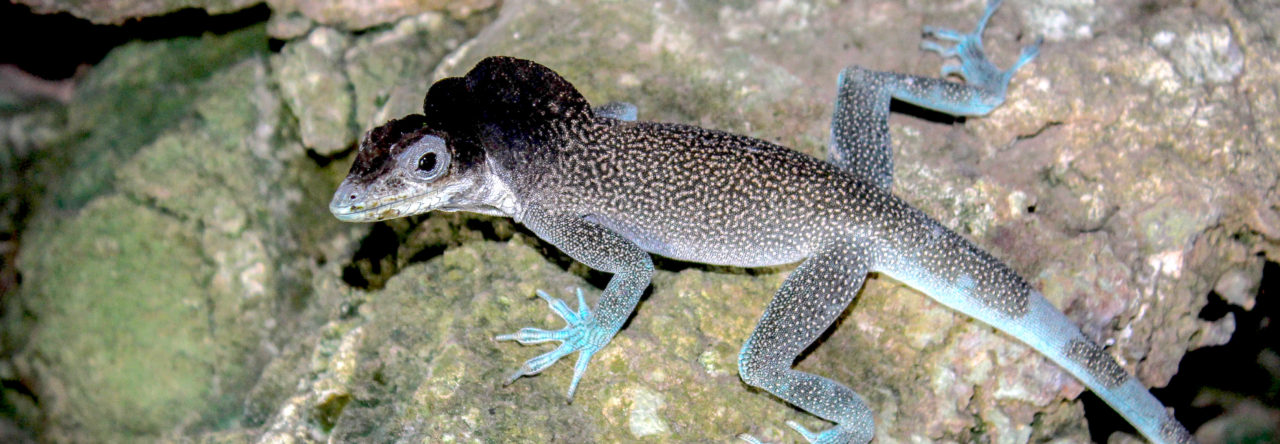Eileen Wickens, who just finished the fourth grade in north central Florida, is a lizard-catching machine and particularly adept at nabbing blue-colored green anoles (Anolis carolinensis). Here’s the story, relayed by her mom, Carissa:
The teal lizards do seem rare as we have only seen a few. We had one at our house last spring and the photo I sent you was taken at our horse teaching unit in Gainesville. We were running an equine behavior trial that day (we’re actually investigating startle phenotypes and genetics in our Quarter Horse herd), and I saw the lizard as we were packing up our gear. My daughter is very good at spotting and catching them, so we will definitely keep our eyes out and would be happy to provide a specimen for your genetic research if we can. I’ve attached the photo of the lizard we had at the house last spring. The green anoles are scare in our neighborhood and on campus compared to the brown anoles (short snouts with distinct, dorsal diamond or striped markings). They seem to far outnumber the greens.
From our brief observations of those two blue lizards this past year it does not appear they turn the bright green you see on the other Carolina Anoles, but it would be good to observe them for a longer period of time to be certain.
- Third Mexican Amber Anolis Lizard Discovered - January 14, 2025
- Anolis Lizard Research Paves the Way for Advances in Treatment of Human Prostate Cancer - January 10, 2025
- When Two Lizards Meet for the First Time, Scientists Witness Evolution in Action - January 3, 2025



Pat Shipman
Wow!
Janson
Everything about this is ridiculously awesome. The blue A. carolinensis and Eileen and her mother’s engagement. Just tremendous! In Volusia/Flagler counties (east coast of northern central Florida), I can’t say that I’ve seen *any* this blue. I’ve seen a few blue-green over the years, but not enough that I’d ever say “blue” in describing them. This is fascinating.
Dusty Rhoads
This is great. I hope Carissa and Eileen can provide one or a few for the Losos Lab to learn more about xanthophores. In 2014, I included in a regional herp publication a really cool photograph of an axanthic blue phase Anolis carolinensis female in the throes of passion—breeding with (and having her nape gnawed by) a normally pigmented green male. The photo was taken by a captive breeder of reptiles named Maurice Pudio II.
The article I wrote is titled: Rhoads, Dustin. 2014. Citizen Herpetology, Part 2—Some of the Questions that Molecules Can Answer. SWCHR Bulletin 4(2): 13-19.
And a PDF can be downloaded here: http://dustyrhoads.x10host.com/Dusty_Rhoads_-_snake_biology/Publications_files/rhoads_dustin_2014_citizen_herpetology_pt2_swchr.pdf
cwickens
We appreciated reading your comments. Thank you! Sad to report that in the months since the Losos lab kindly posted Eileen’s finding, we have not been able to find any blue anoles. We will keep our eyes out as spring arrives. The extremely cold temperatures these past few weeks have resulted in very few lizard observations.
Hermann
Have you seen anymore of these little guys?
Tony Duncan
I just saw my first blue Anole. Here in Jacksonville Fl.
cwickens
That’s awesome. We currently have one female green anole at the house. She has a favorite spot in the backyard/corner of the house behind the down spout. My daughter’s caught and released her a few times this past week with the warmer weather. No blue anole sightings unfortunately. We also noticed this particular green anole looks thin. Assuming some level of fasting occurs when the weather is so cold as it’s been this winter.
Sandi
Found this fella in Baton Rougee, La.
No green on him at all.
Clara
I saw one in my back garden (Fort Worth, Texas) last month! We are used to the green and brown anoles, but I had never found a blue before. Glad I was not going crazy!